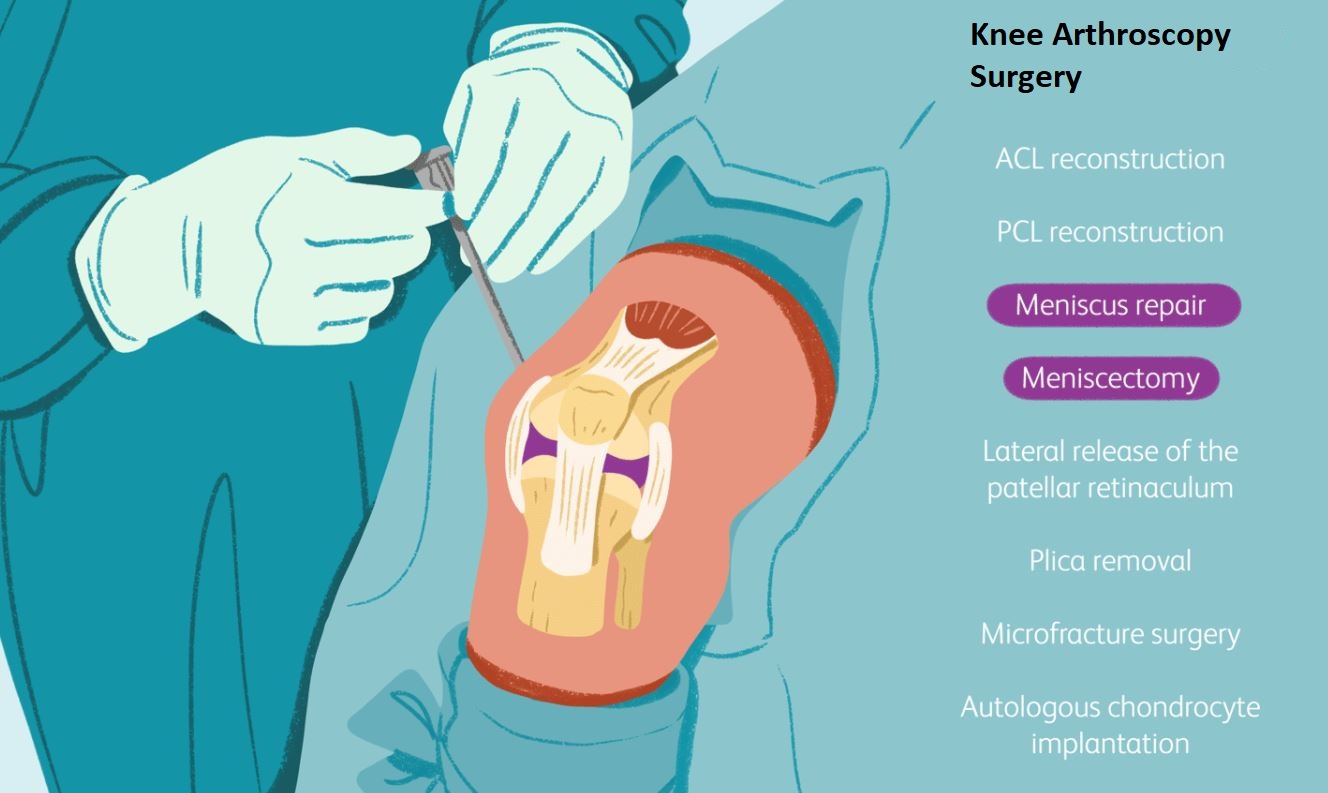Arthroscopy is an operation that helps determine the cause and treatment of any problems in the joint. Doctors can use Arthroscopy to diagnose and treat joint problems. Arthroscopic Surgery is performed on an outpatient basis which means you can return home the same day. Your doctor may recommend this surgery if you have joint inflammation or any previously damaged or injured joint part. It’s most common to perform arthroscopy on the knee, wrist, elbow, ankle, and hip.
The surgeon makes a small cut within the patient’s skin through which small instruments, tiny lens and lighting equipment (arthroscope) are inserted. Arthroscope magnifies the joints’ structures with the light transmitted by fiber optics. It is connected to a TV camera, and the inside of the joint appears on the TV monitor.
Knee Arthroscopy Surgery
If non-surgical treatment is ineffective, several knee conditions may require arthroscopic surgery. Meniscal tears, ligament injuries, and loose bodies are all common conditions. Knee arthroscopy is usually an outpatient procedure done under general anesthesia. The arthroscope and other instruments will require a few incisions. Many procedures can be done arthroscopically, depending on the condition. Depending on the type of surgery, you may need crutches, a walker, or physical therapy.
After knee arthroscopy, most people can return to their normal activities in a short span of time. It all depends on how the surgery is done.
In certain situations, you might require Knee replacement. It is a type of arthroplasty which means the surgical repair or reconstruction of a particular joint. This procedure involves the surgical reconstruction of degenerated joints and their replacement with human-made prosthetics or artificial parts. Knee Replacement Surgery Cost in India is much lower than in many other western countries, and these costs depend on the type of knee replacement performed.
Shoulder Arthroscopy
Shoulder arthroscopy is used to diagnose and treat problems in the shoulder joint. A small camera attached to a small device is inserted into the shoulder to diagnose and treat pain. Miniature surgical instruments can also be inserted into the shoulder to assess the problem. This type of surgery is called arthroscopic shoulder replacement. The surgeon is guided through each stage of the shoulder arthroscopic surgery by a television screen image. Overall, it’s a minimally invasive procedure that ensures quick recovery.
Hip Arthroscopy
Hip arthroscopy, again a minimally invasive surgery where the surgeon uses an arthroscope to inspect the hip joint.
This allows the surgeon to diagnose the root cause of your hip pain. Arthroscopic treatment may be possible for certain hip conditions. In these cases, the surgeon may make additional incisions (usually one to two) to allow access to special surgical instruments, such as scalpels, or arthroscopic needles.
Recovery
After the arthroscopy is complete, you will be taken to a recuperation room, where you can rest for up to an hour. After surgery, you may feel some discomfort in your joints. Your doctor might prescribe pain medication or exercise, and they may also prescribe aspirin and other medicines to prevent bleeding. Use ice for the first 24 hours to reduce swelling.
To reduce the pain after an arthroscopy, elevate your leg. Use pain medication as directed and avoid alcohol. As you heal, you may require crutches, a brace, or a sling to support your back. Arthroscopic surgery is more effective than open surgery for joint stiffness and pain, and the recovery process is also shorter.
Minor puncture wounds will appear on the body where the arthroscopic instruments were inserted. You may remove the surgical bandages a day after surgery and place tiny strips of tissue to cover the incisions. After a week or two, your doctor will take out non-dissolvable stitches. You’ll need to keep the area dry as much as possible while your wounds heal. You can do this by covering the wounds with a plastic bag while you take a shower.
Your doctor will advise you on what activities you should avoid once you return home. Within a few days, you can usually return to work or school. It usually takes several weeks to complete joint recovery, but it can take several months for your joints to return to normal. Specific exercises or rehabilitation can speed up your recovery, and you can ask your doctor which exercises are safe.
Final Words
The most commonly performed arthroscopic procedures are shoulder and knee arthroscopy, as these joints have enough space to hold the instruments. Modern advances in arthroscopic technology, including miniaturized cameras and needle-sized probes, have made it possible to perform more delicate arthroscopic surgery in the articulated joints of your wrist and ankle.
The technical definition is that any joint may be subject to arthroscopic surgery. Both open and arthroscopic approaches have their pros and cons. The best decision depends on both the prescribed treatment guidelines and the experience of your healthcare provider.
If your healthcare provider recommends against arthroscopic surgery for any reason, you should keep an open mind. Ask as many questions as necessary to fully understand the reasoning. If you are still unsure, seek out a second opinion from an orthopedist specializing in your condition.


